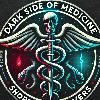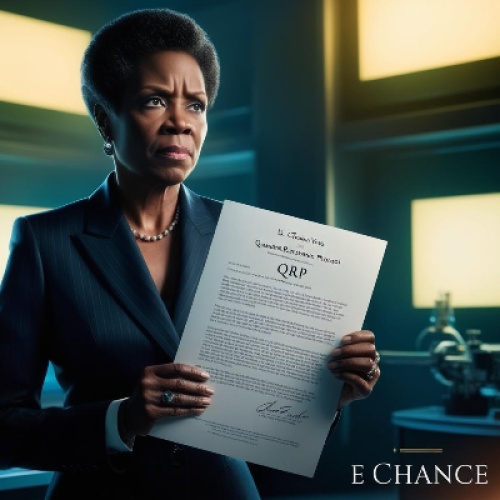A sleek black folder, stamped with the insignia of the Quantum Initiative - an enigmatic government-funded research division - contained a classified algorithm. The accompanying memo was concise: Quantum Resonance Protocol (QRP): Experimental cancer treatment. Priority urgent. Authorization granted. Under the words, a single name appeared: Dr. Lena Roshan, one of the most lauded quantum physicists of the decade.
"Quantum computing? curing cancer?" Glenda whispered to herself, her skepticism as sharp as her curiosity. Yet, as she read further, she couldn't deny the brilliance of the concept. The QRP utilized quantum entanglement to identify and isolate malignant cells with pinpoint precision, dissolving them at the subatomic level without harming surrounding tissue. The potential was astronomical. But buried in the fine print, one chilling phrase repeated: Side effects are unpredictable.
Within weeks, the first trials began under heavy surveillance. Only five patients were accepted into the program - each terminal, their options exhausted. Glenda was both their savior and their warden. Their lives now hinge on an algorithm.
The inaugural test subject was Deacon Dunn, a former Marine whose liver cancer had metastasized aggressively. The procedure was shockingly simple: a recliner-like pod encased him, electrodes mapping his neural and physical responses while quantum servers hummed ominously in a nearby lab. The room smelled faintly of ozone and antiseptic.
"Will I feel anything?" Deacon asked, voice taut.
"Just light sensations," Glenda reassured him. "The algorithm will do the rest."
When the QRP activated, the servers surged to life with a sound like breaking glass. Deacon's body stiffened, then sagged into unconsciousness. Moments later, scans showed the impossible: his liver - once riddled with tumors - was clear.
The room erupted in stunned applause. But Glenda couldn't shake an uneasy thought: If the cure was so clean, why had the memo warned about unpredictable side effects?
The next morning, Deacon's vitals were perfect. His appetite returned; his pain vanished. Yet, when Glenda entered his room, she found him staring at the wall, unblinking.
"Deacon?"
He turned slowly. His eyes shimmered with an otherworldly intensity. "Dr. Voss," he said, his voice unnervingly calm. "I saw things. A world beyond ours."
Glenda frowned. "That's common with sedation - dream states can - "
"No," he interrupted. "This wasn't a dream. I understood everything. How atoms hum. How time folds. It's all connected. And?" His voice dropped. "Something else saw me, too."
Before Glenda could respond, his monitor beeped frantically. His heart rate spiked, then normalized. Yet his expression remained unsettlingly serene.
The remaining four patients experienced similar transformations. Their cancers dissolved as if by magic. Their bodies rejuvenated. But their minds shifted. Each described inexplicable visions: parallel realities, infinite versions of themselves, and entities whose motives were indecipherable but distinctly present.
"It's like their consciousness is being untethered," Lena Roshan explained during a closed-door meeting. Her calm demeanor clashed with the storm brewing in her eyes. "The algorithm's entanglement process isn't just targeting cancer cells. It's dipping into quantum states of existence. We're unmooring them from this reality."
"Can it be stopped?" Glenda asked.
"Not without losing the cure," Lena replied.
Glenda felt her stomach knot. Humanity's oldest adversary - cancer - had finally met its match. But at what cost?
By the third week, the side effects had escalated.
Deacon began experiencing blackouts. Security footage revealed him walking through locked doors, his body flickering as though he existed in two places at once. Another patient, Blanche Solis, painted vast murals of fractal landscapes she swore were glimpses of other dimensions. Her words grew cryptic: "We are the cure... and the disease."
Then came the incident.
At 3:42 AM, every patient's monitor flatlined simultaneously. Glenda sprinted to the ward, fearing the worst. Instead, she found them all standing - awake, alive, and eerily synchronized. Their eyes glowed faintly, as if lit from within.
"Dr. Voss," they said in unison, their voices blending into an unnatural harmony. "The cure is complete. But so is the breach."
Glenda's breath caught. "What breach?"
"Your world is not ready," they replied. Then, as abruptly as it began, they collapsed.
In the aftermath, all five patients recovered physically, their cancers permanently eradicated. But their minds were irrevocably altered. Deacon vanished one night, leaving behind only a cryptic note: I'm going where I belong. Blanche's paintings became more abstract, resembling star maps that no astronomer could decipher. The remaining patients avoided sleep, terrified of what they might see.
The QRP was shut down, its data encrypted and buried by bureaucratic red tape. Officially, the program was deemed a success. Unofficially, Glenda knew better.
She stared at the black folder on her desk one last time before locking it away. Cancer might have met its match, but the implications of the cure - and the glimpses of a fractured reality it revealed - posed a new question:
What if some diseases were meant to remain unsolved?





